Exploring the Impact of 100-Foot Waves on Nature and Sports
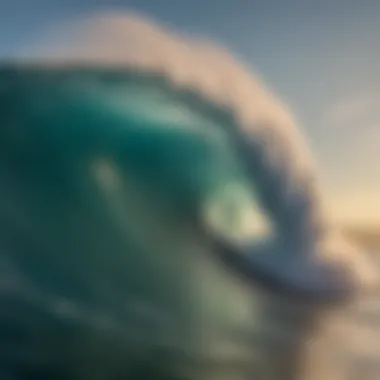
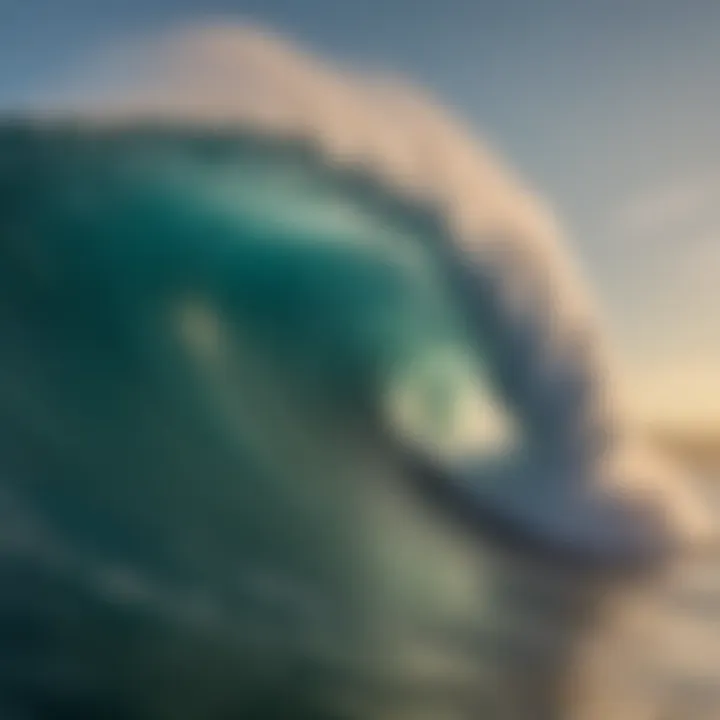
Intro
Waves that tower over coastal scenery, reaching heights of hundred feet, have carved a niche in the narratives of oceanography and extreme sports. For many surfers, these gargantuan waves may appear as the ultimate thrill ride, a challenge that dares them to test their limits. However, behind this allure lies a tapestry of geological processes and environmental factors that shape their existence.
The formation of these monstrous waves is no casual affair. It involves a medley of oceanic conditions, wind patterns, and seafloor topography playing a crucial role. As we unpack the essence of 100-foot waves, we begin to realize that these awe-inspiring entities bring not just wonder but also significant implications for nature and human endeavors alike. Their impact is felt acutely in the watersports community, where enthusiasts and professionals alike tread the fine line between exhilarating experience and dire peril.
To fully grasp the complexity tied to these waves, it’s vital to delve into the various facets that affect them—from the geological roots that trigger their formation to the safety concerns and training necessary to ride them responsibly. This article will take you on a comprehensive journey, exploring the 100-foot wave phenomenon and its far-reaching implications.
Understanding the Concept of a 100-Foot Wave
The occurrence of a 100-foot wave is a remarkable phenomenon that commands not just attention but also demands respect. Understanding it goes beyond just measuring height; it's about grasping its implications for nature, marine ecosystems, and the countless souls who dare to ride its formidable face. Surfers, oceanographers, and even climate scientists find value in comprehending these giants, drawn into a whirlpool of fascination that mixes beauty with peril.
Defining the 100-Foot Wave
A 100-foot wave refers to an ocean wave that stands at least 100 feet from trough to crest. While it’s tempting to think these waves are mere anomalies, they are the result of a complex interplay of factors, including wind, current, and sea bed geology. Often, they are born from massive storms—hurricanes, typhoons, or strong winter gales. In surf culture, we also hear terms like "big wave" or "colossal waves," but the common yardstick remains the 100-foot benchmark. This exceptional height often translates to a thrilling yet treacherous experience for deep-sea surfers.
An interesting tidbit: The sheer force of a 100-foot wave is mind-boggling. With water moving at terrifying speeds, the energy contained within such a wave can be larger than that of an atomic bomb. In terms of definitions, experts might reference wave classifications such as swell, chop, or fetch, but at the core of every monstrous wave is the same dance of ocean physics.
The Significance in Watersports
Big waves hold unparalleled significance in the realms of watersports, serving as both a challenge and an enchantment. For surfers, riding a 100-foot wave is often seen as the ultimate achievement, akin to reaching the summit of Everest for climbers. However, this allure comes with considerable risks. Many dream of conquering the ocean, yet few possess the skills necessary to safely navigate such turbulent waters.
These gargantuan waves are more than just feats of athleticism; they represent the spirit of adventure. Surfers harness hard-earned experience, training in smaller conditions before diving into the deep. Understanding this culture is essential not only to appreciate the beauty of the sport but also the respect these athletes have for the ocean.
Moreover, the adrenaline rush of facing a towering wave pairs with larger philosophical questions: What draws humans to risk it all, standing within nature’s fury? The relationship between surfers and these waves becomes one of mutual respect. They recognize that to ride the 100-foot wave is to participate in a delicate ballet of power and submission, where success is measured not just by victory but by survival.
"Surfing is something you have to experience. It's as much about understanding the risks as it is about embracing the thrill."
Gear, preparation, and mental fortitude play vital roles, elevating the surfer’s readiness to face enormous challenges. Just as with mountaineering or any extreme sport, mastering the essentials of big wave surfing demands patience, experience, and a willingness to face fear head-on. The significance of understanding 100-foot waves extends beyond the individual surfer; it resonates within the community, drawing enthusiasts closer to the ocean's cryptic complexities.
Geological Foundations of Colossal Waves
Understanding the geological foundations of colossal waves is crucial to grasping how these massive natural phenomena form. The interplay of earth’s tectonic forces with the ocean's surface creates conditions ripe for gigantic waves. Both tectonic activity and ocean currents significantly contribute to the mechanics of wave formation, making this a pivotal area of study for scientists and watersports enthusiasts alike.
Tectonic Activity and Undersea Topography
Tectonic activity is often the unsung hero behind the creation of enormous waves. The Earth's crust is in a constant state of motion, shifting along fault lines and causing underwater earthquakes. These seismic events can displace vast amounts of water, leading to the formation of waves that can reach astounding heights, sometimes surpassing 100 feet. For instance, the infamous 2004 Indian Ocean earthquake generated devastating tsunamis that dramatically altered coastal landscapes.
Moreover, the undersea topography also plays a significant role. The varying depths of the ocean floor can amplify wave height. When a wave travels over shallower areas, its energy gets compressed and results in towering waves. Thus, regions with steep underwater slopes are susceptible to these gigantic waves, as they reflect the energy upward, creating more formidable conditions.
To illustrate, consider the continental shelf's role. Areas with a broad continental shelf might experience gentler waves, as the wave energy diffuses over a larger area. On the flip side, steep ridges can produce sudden drops in water depth, leading to rapid wave formation. This reflects how vital it is to understand the oceanic topography for anyone interested in big wave surfing, as the topography dictates the type of waves surfers will encounter.
"The ocean is a mesmerizing beast, but one has to respect its depths and sudden changes; big waves are a reminder of nature's power."
Impact of Ocean Currents
Ocean currents are another significant factor influencing the creation of large waves. These currents, largely driven by wind patterns, solar heating, and the rotation of the Earth, create a dynamic environment where colossal waves can thrive. The interaction between warm and cold currents can lead to turbulence and increased wave sizes. Regions where these currents converge can act as breeding grounds for massive swells.
For example, the North Atlantic Ocean sees the convergence of the Gulf Stream and the North Atlantic Current, creating ideal conditions for powerful waves. Surfers often flock to places like Mavericks in California, where these oceanic conditions culminate in world-renowned big waves.
Furthermore, currents contribute to the directionality of waves. When hunting for the perfect waves, surfers need to keep an eye on ocean currents’ flow, as they can be the difference between a thrilling ride and a chaotic tumble. Understanding how currents influence wave behavior is essential not just for surfers but also for those involved in oceanographic research, coastal development, and marine conservation.
In summary, the geological foundations, comprising tectonic activity, undersea topography, and ocean currents, are integral to understanding the formation of 100-foot waves. Knowledge of these factors can empower watersports enthusiasts with critical insights that not only enhance their surfing adventures but also contribute to broader discussions on environmental sustainability and safety in extreme conditions.
Meteorological Factors Influencing Wave Formation
Understanding the meteorological factors that contribute to wave formations, especially colossal ones like 100-foot waves, is crucial. Weather systems play a pivotal role in creating the conditions needed for these massive waves to form. By analyzing storm patterns, wind direction, and local atmospheric conditions, one can appreciate why and how these waves occur.
Several elements come into play:
- Storm Surges
- Wind Patterns
By dissecting these two main components, we can not only grasp the science behind wave formations but also the implications they carry for watersports enthusiasts.
Storm Surges and Their Effects
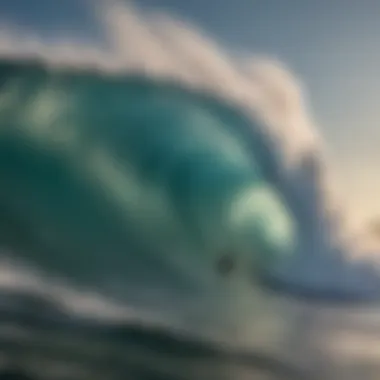
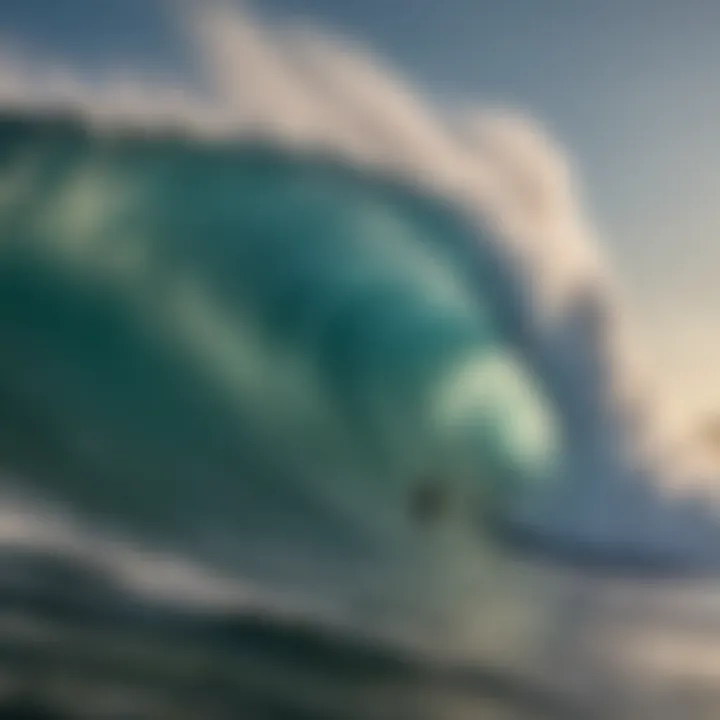
Storm surges arise primarily during significant weather events, particularly hurricanes and intense tempests. As these storms approach, low-pressure systems create a difference in atmospheric pressure that can lead to drastic ocean surface level changes. The wind, coupled with the storm's rotational energy, pushes water toward the shore, consequently raising water levels. This phenomena is exacerbated when a storm strikes during high tide, potentially leading to devastating consequences.
For surfers, understanding the nature of storm surges is vital for several reasons:
- Safety Concerns: Increased water levels can lead to unusually powerful waves that are highly unpredictable. Surfers need to be keenly aware of these changes to avoid dangerous conditions.
- Wave Size & Quality: Often, the result of a storm surge is an increase in the size and intensity of waves. While this can mean thrilling sessions for experienced surfers, it holds significant risks for the ill-prepared.
- Erosion and Habitat Impact: It’s not just surfers that are affected; coastal ecosystems face challenges, too. The surge can lead to erosion, reshaping the natural landscape, which impacts both human activities and marine life.
"A storm surge can transform the ocean into a raging beast, capable of sweeping everything in its path."
Wind Patterns and Their Contribution
Wind is the life force of waves. Its direction, speed, and duration directly influence wave formation. The energy imparted by wind to the water surface is what gives rise to those significant swells that surfers crave.
- Consistent Winds: For big waves to become a reality, there often needs to be sustained wind patterns—sometimes lasting days or weeks—across the open ocean. When wind travels across a vast expanse of water, it creates waves that can evolve into giants.
- Local Effects: Areas like Cape Fear or Jaws in Hawaii are prime examples where local wind patterns combine with unique ocean floor topographies to foster significant swells, making these destinations revered among surfers and adventurers alike.
- Changing Patterns: With climate change influencing global wind systems, surfers may face new challenges. Winds could evolve, leading to different conditions in historically predictable surfing spots, affecting not just safety but how we approach surf culture.
By recognizing wind patterns' critical role in wave formation, watersports enthusiasts can enhance their understanding of the ocean's behavior. Studying local and global wind systems contributes not only to thrilling and safe experiences but also opens doors for innovative surfing practices.
In mastering these elements, surfers equip themselves not just with knowledge, but with a deeper respect for the ocean’s might.
Notable Events Involving 100-Foot Waves
When we talk about the 100-foot wave, we can't overlook the notable events that have captured the attention of the world. These events not only showcase the sheer power of nature but also highlight the complexity and risks involved in surfing these mammoth waves. Understanding these events provides insight into how extraordinary phenomena influence both the sport itself and the marine environment.
Historical Documentations
Throughout history, there have been instances where massive waves have led to significant events, both tragic and triumphant. In the annals of surfing, perhaps the most famous event was the Big Wednesday swell in October 1982 at Malibu, California. Surfer Greg Noll, known for his daring spirit, faced waves that were at least 30 feet, perhaps even reaching that legendary 100-foot mark as the swell came through.
Moreover, the 2004 Sri Lanka tsunami, while not a surfing event, serves as a stark reminder of the destructive potential of massive waves. It was a real epiphany for the world about the ferocity inherent in ocean activeness. Thousands lost their lives, and the tragedy opened discussions about safety, preparedness, and response to large wave phenomena.
In surf culture, there's a longstanding tale about the 1998 Jaws swell in Hawaii, where surfers had to reckon with monumental waves. There, legends were made, and the sport took a turn toward extreme challenge and competition, forcing surfers to rethink their techniques and equipment as they battled nature’s fury.
"Great waves don’t just demand respect; they require humility and preparation."
Modern Surfing Challenges
In the contemporary surfing landscape, the challenge isn't just about riding high waves; it has evolved into a complex game of strategy, technology, and mental fortitude. Big wave surfing competitions like the Big Wave World Tour have raised the stakes. Each year, surfers wait for suitable conditions, often driven to remote locations such as Maverick's in California or Teahupo'o in Tahiti, places known for their intimidating wave heights.
Surfers today are faced with new obstacles, such as:
- Dealing with the unpredictability of weather patterns and wave behaviors.
- The growing concern surrounding climate change and its impact on wave formations.
- The necessity of utilizing advanced surf technology, such as jet skis for tow-in surfing, lifeguard support, and safety equipment.
These modern challenges require surfers to develop not only physical skills but also mental resilience. The psychological strain of preparing for a 100-foot wave can take its toll. From anxiety management to the pressure of performance, every aspect is paramount.
Safety Considerations for Watersports Enthusiasts
When it comes to engaging in activities on or near the ocean, understanding safety concerns is not just sensible—it’s essential. The allure of 100-foot waves has drawn many watersports enthusiasts, but with that excitement comes the reality of risks that, if not managed correctly, can turn thrill into tragedy. This section unpacks the necessity of risk assessment and awareness, along with best practices in surviving these colossal waves.
Risk Assessment and Awareness
Before paddling out into the vast, unpredictable ocean, especially when 100-foot waves are on the horizon, a thorough risk assessment must be conducted. Every surfer, sailor, or paddleboarder needs to recognize that each excursion could come with its own unique set of challenges.
- Understanding Wave Conditions: Knowing how to read wave patterns is critical. The ocean isn’t just a playground; it’s a living entity with moods and temperament. Enthusiasts must track local forecasts and examine charts detailing swell size, wind direction, and choppiness.
- Assessing Personal Skill Level: It’s noble to push personal limits, but an honest self-assessment is the foundation of safety. Novices shouldn’t venture into big wave surfing without adequate training or mentorship.
- Environmental Factors: Weather shifts can change the ocean’s dynamics swiftly. Awareness of conditions such as approaching storms or high winds can mark the difference between a good day on the water and a perilous situation.
- Understanding Local Hazards: Each surf spot has its characteristics. Pockets of shallow reefs, rocks beneath the surface, and rip currents are hazards waiting to catch the unprepared. Familiarizing oneself with local conditions gives a surfer a fighting chance.
Additionally, it’s wise to connect with locals or veteran surfers. They can provide insight that you might not find in guidebooks.
"In surfing, an informed mind is a safe mind—never rely solely on luck."
Best Practices in Surviving Large Waves
Understanding the dangers is only half the battle; knowing how to navigate designed for such intimidating conditions is where preparation and skill come into play. Here are some practices every watersports enthusiast should have in their toolkit when faced with daunting waves:
- Keep Equipment in Check: Ensure that your board, leash, wet suit and safety gear are in prime condition. Any breakdown in equipment can spell disaster in the heart of a big wave.
- Use a Partner System: Solo surfing in treacherous conditions is risky. Always have a buddy with you and set clear emergency signals, so you both can respond quickly if one gets into trouble.
- Know When to Exit: Not every session is worth risking life and limb. An experienced surfer knows their limit and isn’t afraid to back paddle when the conditions surpass individual skill level.
- Practice Fall Techniques: In the face of a high wave, knowing how to fall can save you from injury. Tuck and protect your head and neck, and try to swim downward while the wave passes.
- Capitalize on Safety Equipment: Leashes and floatation devices are not merely accessories; they are lifelines in the surf. Equip yourself appropriately to navigate through intense surf.
Keeping these best practices at the forefront can turn a potentially dangerous encounter into a manageable scenario.
As the ocean roars and the waves tower high, understanding safety considerations transforms every adventure into a calculated endeavor, allowing athletes and enthusiasts to ride the unparalleled power of the ocean while minimizing risk.
The Allure of 100-Foot Waves for Surfing
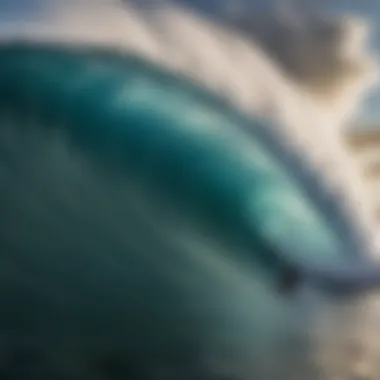
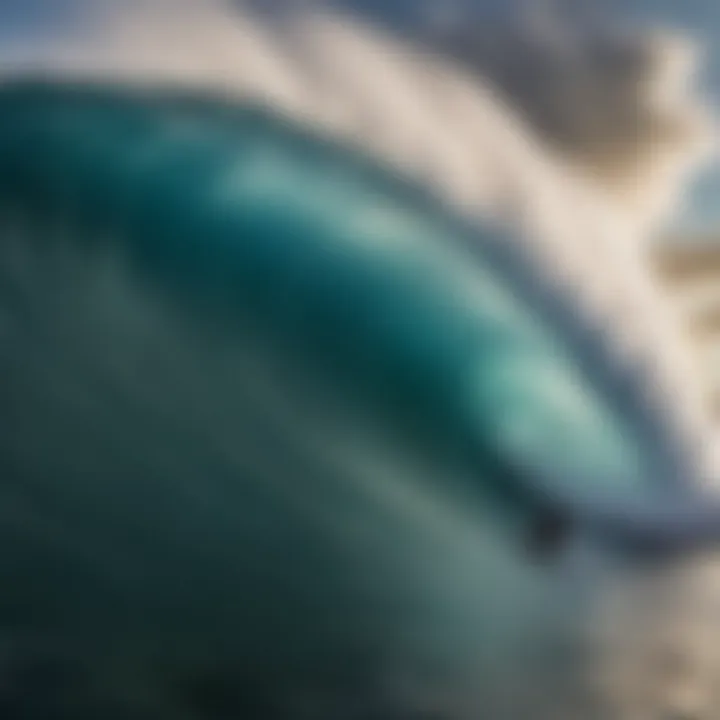
The fascination with 100-foot waves extends far beyond mere spectacle; it draws in surfers, adventurers, and ocean enthusiasts with a unique allure. For many, the pursuit of riding these colossal waves represents more than just surfing; it's a test of limits, both physical and mental. This section dives into the psychological dimensions that compel individuals to challenge the ocean's fury and highlights some of the most distinguished surf spots where these waves can be encountered.
Psychology of Big Wave Surfers
When we peer into the minds of big wave surfers, we uncover a complex interplay of thrill-seeking, adrenaline, and sometimes, a tinge of insanity. The allure of catching a 100-foot wave speaks to a deep-seated drive to conquer formidable challenges. For these surfers, riding such waves isn’t merely about standing on the board; it's about embracing fear and turning it into exhilaration.
There exists a phenomenon known as "sensation-seeking," where individuals seek out intense experiences to satiate their adventurous spirit. Big wave surfers epitomize this trait, chasing adrenaline highs that few can fathom. Surfers like Laird Hamilton and Garrett McNamara stand as icons in this world—individuals who’ve deliberately sought out the extreme, pushing the limits of what seems humanly possible, all while remaining connected to the elemental forces of nature.
Even their preparation for surf sessions is steeped in psychological strategy. Many meditate or visualize the ride, honing their focus to combat potential anxieties when faced with the sheer magnitude of the waves. It’s a blend of instinct and preparation, a dance between chaos and calm that defines their experience. The community surrounding big wave surfing adds layers to this allure—binding surfers in a shared mission and respect for the ocean.
Often, after a successful ride, there's a blend of relief and elation, signaling an almost transcendental truth of accomplishment. The drive to ride these mighty swells is fueled not just by the thrill, but by a sense of proving oneself against nature itself.
Notable Big Wave Surf Spots
The quest to ride 100-foot waves is not confined to just any stretch of ocean; specific locales around the globe have become legendary for their monstrous swells. Here are some of the most notable spots:
- Nazaré, Portugal: Known for its enormous waves, Nazaré has become a pilgrimage for surfers world-wide. The underwater canyon creates conditions that can stir up massive waves, leading to breathtaking rides and jaw-dropping feats. Events held here have drawn crowds not just for the surfing, but for the spectacular display of nature's power.
- Mavericks, California: Situated just off the coast of Half Moon Bay, Mavericks is infamous for its unpredictable and giant waves, which can reach astonishing heights. Surfers brave enough to tackle its waters are often met with cold temperatures, jagged rocks, and the thrill of nearly vertical drops.
- Jaws (Peahi), Hawaii: Known among surfers as Jaws, this famed location on the island of Maui produces waves that can easily match or exceed the 100-foot mark. The sheer force of these waves, coupled with the stunning Hawaiian backdrop, draws surfers from around the globe to test their mettle upon its surface.
- Teahupo'o, Tahiti: This spot may not regularly reach 100 feet but when it does, it becomes le formidable. The shallow reef breaks here demand not only skill but also a healthy respect for the ocean's power, making it a coveted location for top surfers.
As the waves approach, immense respect for the ocean’s unpredictability and power is essential. Location often dictates the surfer's fate amidst these natural giants.
The Role of Technology in Big Wave Surfing
Technology has woven itself into the very fabric of big wave surfing, transforming how surfers approach these titanic swells. The relationship between the advancements in gear and the utilization of drones for safety is significant. Such technological tools not only enhance performance but also uphold the safety and longevity of those daring enough to face these colossus waves. From high-tech boards to advanced monitoring systems, the benefits of technology are manifold.
Advancements in Surfing Gear
The world of surfing gear has seen tremendous leaps over recent years. Surfers today are no longer confined to the basic boards of yesteryears. Now, they have access to performance-enhancing equipment that could be considered almost futuristic.
- Materials: The introduction of lighter and more durable materials such as carbon fiber means that boards can be designed to withstand greater pressures, while being easier to maneuver.
- Shape: Surfboard shapers are utilizing computer-aided design to create precision shapes, tailored for optimal performance in massive waves. These designs consider factors like hydrodynamics and volume distribution.
- Safety Features: Innovations such as impact foam and reinforced rails make it less likely for surfers to sustain injuries. These safety measures are crucial when navigating the unpredictable nature of 100-foot swells.
Beyond the boards, wetsuits are also transforming. With advancements like heat-retaining technology and flexible neoprene, surfers can remain comfortable in often icy waters, extending their time in the ocean.
"The technological evolution in surfing gear has redefined what it means to tackle big waves, pushing boundaries that were once thought unapproachable."
Use of Drones for Safety and Research
In recent times, drones have made quite a splash in big wave surfing, serving both safety and research purposes. The aerial perspective they provide is invaluable, not just for surfers, but for entire coastal communities.
- Real-Time Monitoring: Drones can give surfers a bird's-eye view of incoming waves, helping them gauge the optimal conditions for riding. These flying devices relay critical information, such as wave size, current speed, and hazards.
- Rescue Operations: In cases of accidents, drones can be deployed to locate missing surfers or those in distress. The ability to cover vast areas quickly is a game changer in emergency scenarios.
- Research and Conservation: Drones are also being used for ecological monitoring of marine environments. By studying how massive waves affect coastal ecosystems, researchers can provide valuable insights that could influence conservation efforts.
The integration of these technologies highlights a broader trend in outdoor sports where safety meets innovation. It's a dance between thrill-seeking and responsible practice, ultimately contributing to the evolution of big wave surfing.
Environmental Impact of Massive Waves
The consequences of encountering colossal waves extend beyond the thrill of watersports. Massive waves, especially those reaching 100 feet or more, can dramatically reshape coastlines and have profound implications for marine ecosystems. Recognizing the ecological impact of these waves is essential not just for environmental enthusiasts, but also for athletes, hobbyists, and outdoor adventurers who engage with these natural giants.
Erosion and Coastal Effects
When these titanic waves crash upon the shore, they wield immense power. The force exerted can lead to significant coastal erosion, reshaping the land with each tide. This erosion is not merely about the loss of beachfront property; it has deeper implications for local habitats.
- Loss of Land: Coastal regions are at risk of losing sandy areas that support both human activities and wildlife. Homes, roads, and recreational areas may vanish, leading to economic implications.
- Sediment Movement: The reshaping of coastlines causes shifts in sediment distribution, affecting local ecosystems. Changes in substrate can impact the plants and animals that thrive in specific environments.
- Increased Flooding: Higher waves can lead to substantial flooding during storms, jeopardizing both human habitats and natural wetlands which play crucial roles in absorbing excess rainwater.
- Changes in Water Quality: The turbulence created can stir up sediments, affecting the clarity and quality of coastal waters
Understanding coastal erosion starts with recognizing the natural processes at work, but human intervention can exacerbate the situation. Rebuilding structures and shores to resist erosion can often damage local habitats. Hence, striking a balance between protection and preservation is essential.
Implications for Marine Biodiversity
The impact of 100-foot waves reaches beyond the shore, offering a mixed bag of challenges and opportunities for marine life. Massive waves can disrupt the delicate balance of underwater ecosystems in several ways:
- Habitat Alteration: The extreme force associated with large waves can modify underwater landscapes. Rock formations, coral structures, and other vital habitats may be either destroyed or newly created, leading to shifts in species distributions.
- Nutrient Redistribution: On the positive side, these waves can stimulate nutrient mixing, promoting phytoplankton blooms, which are foundational for marine food webs. These blooms can attract a variety of marine species, including fish, which then draws in predators.
- Stranding Risks: However, while some species thrive, others may find themselves stranded and exposed. Smaller marine organisms may not withstand the impact, leading to potential declines in certain populations.
- Migration Shadows: The turbulence also allows strong currents, which can affect migration patterns of fish and other marine creatures, potentially leading them away from traditional spawning grounds.
Emphasizing the need for ongoing research is crucial. Understanding these dynamics can help better manage coastal ecosystems in the face of climate change and escalating extreme weather conditions.
"The ocean's power is both beautiful and destructive, reminding us of nature's unpredictability every time a colossal wave crashes ashore."
As adventurers and enthusiasts, recognizing these impacts paves the way for a deeper appreciation of our oceans. Being informed is as important as riding the waves.
Cultural Representations of Large Waves
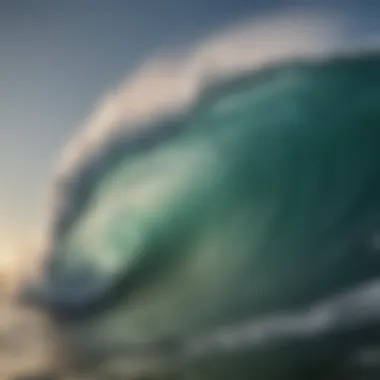
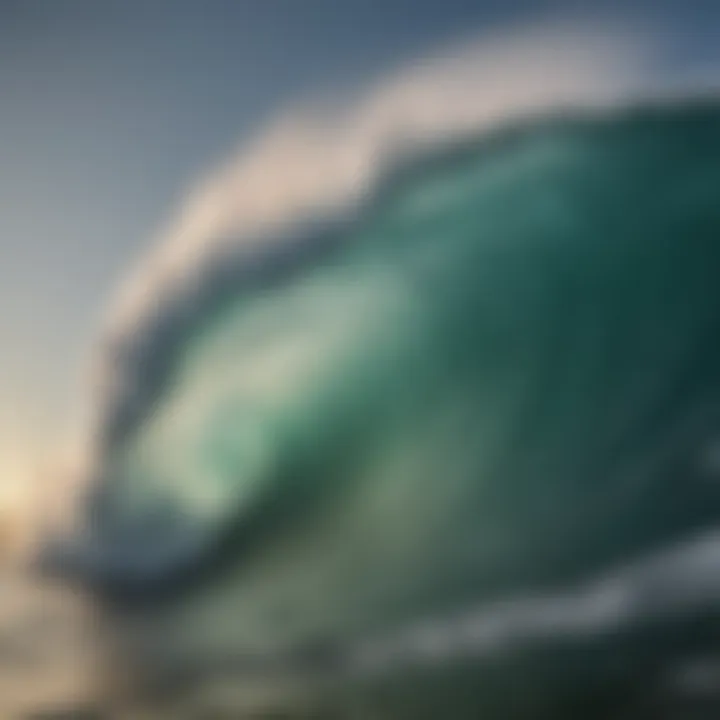
The fascination with large waves extends beyond mere observation; it permeates artistic expression and literature alike. This cultural representation is significant in interpreting how humans relate to natural phenomena and understand their power. Not merely seen as threats or obstacles, these enormous waves inspire creativity and reverence, which can influence society’s perception and response to such forces.
Artistic Interpretations
Art has always been a medium through which humanity communicates its deepest emotions, fears, and aspirations. Large waves have often been depicted in paintings, sculptures, and even digital art. For instance, Hokusai's famous woodblock print, "The Great Wave off Kanagawa," displays not just the sheer power of the sea but also the vulnerability of humans against nature’s unbeaten odds. This piece, like many others, captures the high drama of colossal waves and portrays a delightful tension between the fragile human spirit and the unforgiving ocean.
Artists routinely draw inspiration from the beauty and danger encapsulated within massive waves, translating that energy into their works. Surf culture has also played a significant role in this artistic milieu, often depicted in various media forms. The representations vary from serene, tranquil scenes that emphasize the beauty of surf to chaotic, dynamic environments showcasing the waves’ ferocity. This artistic diversity inspires viewers to reflect on their relationship with the ocean and recognize the duality of awe and fear.
- Benefits of Artistic Interpretations:
- Enhances awareness and appreciation for nature.
- Encourages dialogue on conservation and environmental issues.
- Offers a therapeutic avenue for processing fear and respect for powerful elements.
Literature and Media Portrayals
Literature and film frequently underscore the intrigue surrounding large waves, weaving tales that emphasize humanity’s skirmishes with nature. Take, for example, the novel "Life of Pi" by Yann Martel, where the protagonist encounters a vast ocean populated with dangers, not least an enormous wave that solidifies the reader's understanding of nature's unpredictability. These portrayals generate not only suspense but also a philosophical reflection on survival and coexistence with nature.
Filmmakers have also portrayed oceanic waves in dramatic ways. Documentaries showcasing surfing phenomena, like "Riding Giants," celebrate the spirits of those who confront these giants head-on. These media interpretations allow viewers to experience the thrill and danger of massive waves vicariously while promoting an appreciation for the skill involved in dealing with such unpredictable elements.
- Key Themes in Literature and Media Depictions:
- Nature’s indifference to human struggle.
- The challenge of overcoming fear to achieve personal aims.
- Refinement of skills and respect for nature.
"Nature's fury is unleashed in waves, reminding us of our smallness in the universe while fueling our ambition to conquer it."
In summation, cultural representations of large waves offer a multifaceted view of how society interacts with natural phenomena. Through artistic interpretations and media portrayals, the awe and challenges posed by these colossal waves enrich human experience, encouraging deeper understanding and respect for nature's most powerful expressions.
Future Directions for Research and Exploration
As we embark on the journey of understanding the colossal phenomenon of 100-foot waves, it's imperative to shed light on the future directions for research and exploration in this domain. This topic holds significant importance not only for surfers and outdoor enthusiasts but also for scientists and environmentalists focused on the delicate interplay between our natural world and human activities.
Monitoring and Predicting Wave Patterns
Understanding and predicting wave patterns can lead to safer encounters for surfers and minimize risks associated with extreme weather conditions. New advancements in oceanographic technology allow us to capture real-time data regarding wave formations.
Some pivotal elements to consider in this area include:
- Use of Satellite Technology: Satellites provide a broader perspective of ocean dynamics, allowing researchers to analyze wave patterns over large areas. By gathering data on wind speed, ocean temperature, and currents, we can better predict when and where significant waves are likely to form.
- buoy Systems: Floating buoys equipped with sensors can track wave height and frequency, sending alerts for surfers and other water users. Implementing a network of these buoys, especially in surf hotspots, can greatly enhance safety measures.
- Machine Learning: Integrating artificial intelligence to analyze historical data can help identify trends and anomalies in wave behavior. This could lead to improved forecasting models and a greater understanding of the conditions that lead to the formation of 100-foot waves.
Notably, scientists at the National Oceanic and Atmospheric Administration (NOAA) are already utilizing such technologies, enhancing our abilities to understand and monitor oceanic patterns.
Innovative Approaches to Studying Natural Phenomena
Research into 100-foot waves also opens up pathways for innovative methodologies in studying natural phenomena. Traditional approaches sometimes fall short due to the unpredictable nature of these waves.
Some modern techniques being considered include:
- Collaborative Research Ventures: Public and private institutions can work together to create shared databases that track wave occurrences globally. This collaboration can lead to shared insights and better predictive models in the field of marine science.
- Virtual Reality Simulations: Using VR, researchers can simulate wave behavior under various conditions without the dangers present in real-world studies. This not only yields significant data but also engages a broader audience in marine science.
- Crowd-sourced Data Collection: With the prevalence of mobile devices, fishermen, surfers, or casual observers can contribute valuable information regarding wave events they encounter. Engaging the community in research can provide a wealth of real-time anecdotal data that’s otherwise hard to gather.
As we push the boundaries in understanding these massive waves, it becomes clear that a multifaceted approach is paramount. Engaging with various disciplines allows for a comprehensive dialogue that enriches our understanding and helps formulate strategies to coexist safely with the unpredictability of our oceans.
"In the depths of the ocean, we find more than just water; we discover the essence of life, resilience, and the challenges we must navigate—both in nature and within ourselves."
As we look forward, exploring these future directions in research and studying the phenomenon of 100-foot waves not only holds promise for advancing our scientific knowledge but also paves the way for a deeper appreciation of the powerful natural world surrounding us.
End: The Intersection of Nature and Passion
As we close the lid on our exploration into the daunting realm of 100-foot waves, one cannot help but sense the heartbeat of nature intertwined with the spirit of human adventure. This phenomenon isn’t merely about towering water; it embodies a blend of awe, respect, and passionate pursuit that transcends mere enjoyment of watersports.
Reflection on the Pursuit of the Unknown
In every wave lies a story waiting to unfold. Surfers and scientists alike find themselves drawn to the mystique of the ocean’s might. The quest to understand the mechanics of such massive formations is as much about seeking knowledge as it is about conquering fear. For many, riding a 100-foot wave equates to touching the sublime; it tackles the innate urge of humans to explore and overcome the unknown. This pursuit can be both exhilarating and humbling. By pushing boundaries, one often discovers deeper truths about nature and, in parallel, about oneself.
Consider how countless adventurers have risked life and limb to surf these monstrous waves. They aren’t just after thrills; they seek a communion with nature that few other endeavors can offer. Surfers often articulate a sense of oneness with the ocean, sharing an unspoken language that connects them to its raw power. This aspect of the sport highlights a profound respect for the environment, adding layers to their experience beyond mere adrenaline.
Embracing the Challenges Ahead
Yet, as one looks toward the horizon, embracing the challenges presented by 100-foot waves means moving with caution and respect. The allure of big waves brings both glory and peril, urging a reflection on the balance between human ambition and environmental consciousness. It’s a call for responsible engagement with our surroundings. Recognizing the environmental impact of our pursuits is paramount, emphasizing sustainability and respect for marine ecosystems.
Water sports athletes must pass down the wisdom of handling these behemoths while being stewards of the oceans. This dual responsibility enriches the culture surrounding big wave surfing, fostering a community that celebrates not only feats of bravery but also environmental integrity. As we navigate the future of watersports, it becomes vital to leverage technology and research to enhance safety measures. This will ensure that this intense relationship with nature can continue for future generations to embrace and explore.
"The ocean is a masterpiece of nature; riding its waves is an art form that requires skill, respect, and a willingness to learn."
In wrapping up this discussion, we see that the intersection of nature and passion lies at the core of understanding the phenomena of 100-foot waves. Cultivating a mindset that balances exploration with conservation can elevate our experiences while simultaneously ensuring the integrity of the environment we cherish. The journey doesn’t end here; it is merely the beginning of an adventure that beckons the brave-hearted to discover its depths.















